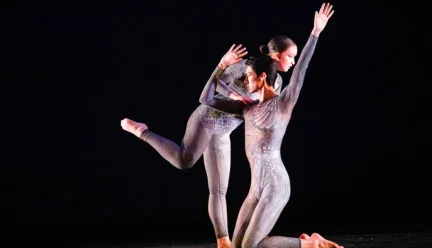Article Text
Originally published in the Illinois News Bureau as October Dance puts a modern spin on dance history by Jodi Heckel.
CHAMPAIGN, Ill. — The October Dance concert “Rewind/Remix” will look back at historical modern dance figures and put a contemporary spin on dance history.
The concert, presented by the University of Illinois Urbana-Champaign dance department, is Oct. 10-12 at Krannert Center for the Performing Arts. A livestream performance is available at 7:30 p.m. Oct. 9.
Dance professor Paige Caldarella danced for choreographer Merce Cunningham’s company, and she teaches his technique. She staged Cunningham’s “MinEvent” for October Dance using Cunningham’s practice of taking excerpts of choreography from his works and combining them into new performances that were unique and could be designed for a specific space. Caldarella said she used excerpts from dances created over six decades so student dancers could experience the range of Cunningham’s choreography and how it changed over time.
She said the Illinois “MinEvent” reflects Cunningham’s interest in technology and his pioneering use of the computer as a choreographic tool, as well as his view that choreography and music are separate entities that can stand alone.
Caldarella worked with music professor Eli Fieldsteel and multimedia technologist and doctoral student in informatics Jake Metz. Fieldsteel said he composed the music for the piece by recording a variety of sounds, including a dancer performing in tap shoes, sounds from nature, sounds made by everyday objects, synthesized tones and filtered noise. He uses a programming language to mix and blend the sounds and, during the performance, he’ll make choices about what sounds to use as the dance unfolds. Fieldsteel said he enjoys the spontaneity and improvisation of this approach, and the collaborative multimedia aspect.
Metz will perform live video accompaniment using a blend of video art techniques. Central to the performance is a system he designed which uses generative artificial intelligence alongside the dancers’ images, audio data from Fieldsteel and text prompts to create representations of the dancers at various levels of abstraction that he controls. He developed this process at the SCIM Lab in the University Library’s Scholarly Commons over the past year. Additionally, video processing software, modular synthesizers and hardware mixers are used to produce textures, shapes and colors that he’ll blend with the output of the generative system in real time.
Dance professor Rachel Rizzuto’s work “Martha and Hanya and Doris and Charles” is based on dances choreographed by the founding four choreographers of modern dance — Martha Graham, Hanya Holm, Doris Humphrey and Charles Weidman. Rizzuto distilled the recognizable movements of each into a work that started as an homage but shifted to satire.
“We’re lovingly poking fun at what have become some classic modern dance tropes in choreography,” Rizzuto said.
For example, she uses what she calls the “modern dancer run,” in which a dancer runs very quickly across the stage with the arms down at the sides, and Humphrey’s “fall and recovery technique,” in which a dancer is always moving between surrendering to gravity and regaining balance. Rizzuto exaggerates the movements, so dancers are running around the stage for a long time and falling over and over.
“Humor is often part of the work I create. I was originally thinking about what made these choreographers special enough to be designated the four pioneers of modern dance and how we translate that to contemporary notions of what good, powerful dance is,” Rizzuto said. “But also, there is a real self-seriousness about their work, which is one of the ways this morphed from homage to parody.”
Dance student Tessa Olson examines moshing in her senior thesis work, “I Inhaled a Whole Handful of This Shaved Plastic and It Was Like Drowning.” Olson said she was inspired by watching a crowd moshing in front of a stage at a house party. As she watched people thrash around and bump into and push one another, she saw similarities with modern dance.
“Moshing is a direct expression of the music in your body,” Olson said.
To choregraph the dance, Olson filmed herself and her cast dancing to different kinds of music and incorporated the movements she liked. She also asked the dancers to recreate their version of Simone Biles’ gymnastic passes by imagining what that movement might feel like.
Composer James Mauck created the music from a playlist Olson made from different eras of punk music, and the costumes also represent different punk rock subcultures.
October Dance closes with dance professor Roxane D’Orléans Juste’s staging of a suite of dances from “The Winged” by choreographer José Limón. Juste danced with Limón’s company for more than 30 years, and as an associate director for the company, she taught and staged several of Limón’s dances in the U.S. and abroad, from large ensemble works to solos and chamber works. She was with the company when “The Winged” was restaged with a new score by internationally known composer Jon Magnussen for a 1996 revival of the work.
“’The Winged’ is beautiful, magical and transcends the passage of time,” Juste said.
The dance is about the desire to fly and find freedom, portrayed through mythological feathered characters, Juste said. The atmosphere on stage reflects the period from dawn through midday to evening. It features solos, duets and ensemble pieces, and Juste adjusted some of the roles written for male dancers to be danced by women on some nights to provide opportunities for more students to be featured, she said.
Khetag Tsabolov, a graduate student in costume design, created the costumes. They are long-sleeved unitards as worn in the original production. Tsabolov’s costumes are hand painted with detailed images of feathers in rust, deep blue and black.
